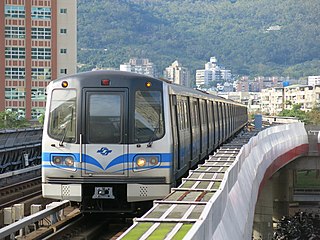
Taipei Mass Rapid Transit (MRT), branded as Metro Taipei, is a rapid transit system serving the capital Taipei and New Taipei City in Taiwan.

The Kawasaki Heavy Industries & Nippon Sharyo C751B is the third generation electric multiple unit rolling stock in operation on the North–South and East–West lines of Singapore's Mass Rapid Transit (MRT) system since early 2000, manufactured by Kawasaki Heavy Industries & Nippon Sharyo (KNS) under Contract 751B. 21 trainsets of 6 cars each were purchased at S$231 million, and it is the first rolling stock to feature VVVF insulated-gate bipolar transistor traction control system. Kawasaki manufactured 66 cars and Nippon Sharyo manufactured 60 cars respectively with no comparable differences, having been built to agreed specifications. These trains are the third generation of rolling stock to be used on the two lines.
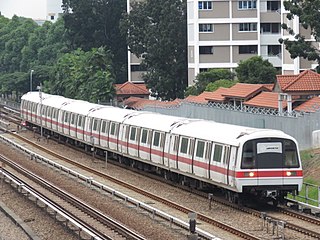
The Siemens C651 is the second generation electric multiple unit rolling stock in operation on the North–South and East–West lines of Singapore's Mass Rapid Transit (MRT) system, manufactured by Siemens Mobility (SIE) and SGP Verkehrstechnik under Contract 651. A total of 114 cars consisting of 19 train-sets were purchased in 1992 and introduced into service from 1995 onwards. These trains were built by Siemens in Austria.

The Kawasaki Heavy Industries C151 is the first generation electric multiple unit (EMU) rolling stock in operation on the North–South and East–West lines of Singapore's Mass Rapid Transit (MRT) system, manufactured by a consortium led by Kawasaki Heavy Industries (KHI) under Contract 151. They were first introduced in 1987 and are the oldest trains in operation on the network.
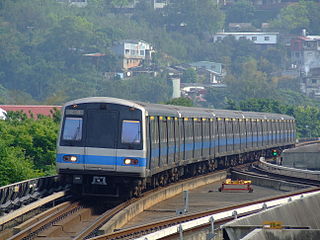
The Taipei Metro C301 is the first generation of heavy-capacity electric multiple units on the Taipei Metro in Taipei, Taiwan. Built by Kawasaki Heavy Industries and Union Rail Car Partnership between 1992 and 1994, it was introduced on the Tamsui line in 1997.

The Keikyu 2100 series (京急2100形) is a DC electric multiple unit (EMU) train type operated by the private railway operator Keikyu in the Tokyo area of Japan since 1998. It replaced the earlier 2000 series on limited-stop Limited Express reserved seat services. A total of 10 8-car sets were built by Kawasaki Heavy Industries and Tokyu Car, and the first sets entered service on 28 March 1998.

The Siemens Modular Metro is a family of electric multiple unit trains for rapid transit systems produced by Siemens Mobility and used by rail operators around the world. The vehicle concept was launched in Vienna in 2000 and is a modular concept allowing many variants of metro vehicles. Previously known as Modular Mobility, Siemens, whose rail equipment division had since been renamed Siemens Mobility, still uses the abbreviation Mo.Mo; however, very little more of these trains are being built, since Siemens had moved to their Inspiro metro platform in 2013.

The Taipei Metro VAL 256 is the first generation of automated guideway transit rolling stock to be used on the Wenhu (Brown) line of Taipei Metro.

The Taipei Metro C371 is the fourth generation of heavy-capacity rolling stock used on the Taipei Metro in Taipei, Taiwan. Built by Kawasaki Heavy Industries and Taiwan Rolling Stock Company between 2005 and 2009, it was introduced on the Xindian and Zhonghe Lines in 2006 and on the Xinbeitou and Xiaobitan branch lines in 2007.

Union Carriage & Wagon (UCW) is a rolling stock manufacturer in South Africa.

The Kawasaki Heavy Industries & CSR Qingdao Sifang C151B is the fifth generation electric multiple unit rolling stock in operation on the North–South and East–West lines of Singapore's Mass Rapid Transit (MRT) system, manufactured by Kawasaki Heavy Industries (KHI) & CRRC Qingdao Sifang under Contract 151B. 45 trains were purchased and all of them have been delivered to Singapore as of 12 April 2017. SMRT took delivery of the first 2 train cars on 21 May 2015. These trains increased frequency for the two MRT lines, North–South and East–West lines.
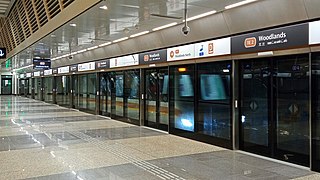
The Kawasaki Heavy Industries & CRRC Qingdao Sifang T251 is the first generation electric multiple unit rolling stock in operation on the Thomson–East Coast line of Singapore's Mass Rapid Transit (MRT) system, manufactured by a consortium of Kawasaki Heavy Industries (KHI) and CRRC Qingdao Sifang under Contract T251.

The Taipei Metro C321 is the second generation of heavy-capacity rolling stock used on the Taipei Metro in Taipei, Taiwan. Built by Siemens Mobility in Germany, it was introduced on the Bannan line in 1999.

The Taipei Metro C381 is the fifth and the latest generation of heavy-capacity electric multiple units on the Taipei Metro in Taipei, Taiwan. They are designed to increase the capacity of the expanded network with the opening of the Xinyi and Songshan lines.

The Bombardier INNOVIA APM 256 is the second generation of automated guideway transit rolling stock to be used on Wenhu line of the Taipei Metro. They are distinguished from their predecessors, Matra VAL256, by their circular front headlights and a grey livery, with a green stripe above. Also, instead of yellow forward-facing seats, the train offers blue seats that face inward.

The LRTA 1100 class is the second-generation class of high-floor light rail vehicles of the Light Rail Transit Authority (LRTA) in Manila, Philippines, which began operation in 1999.
The Bombardier Innovia APM 300R C801B is the third generation of automated people mover (APM) trains built by CRRC Puzhen Alstom Transportation Systems for the Bukit Panjang LRT line, to replace the existing C801 trains built in 1999. The C801B trains are also the first of its kind to reuse the retro AC third rail shoes compared to the newer Light Rail lines around the world that utilises the APM 300 system that have been built with DC third rail instead of AC.
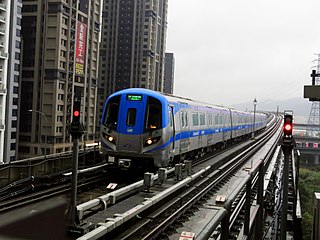
The Taoyuan Metro 1000 series, also referred to as Commuter Trains, are the electric multiple unit train types that are used for the all-stop Commuter services on the Taoyuan Airport MRT.

The Kaohsiung Metro Siemens Modular Metro (Mo.Mo) electric multiple unit (EMU) trains has operated on the heavy-rail Red and Orange Lines since its opening in 2008.

The Taoyuan Metro 2000 series, also referred to as Express Trains, are the electric multiple unit train types that are used for the limited-stop Express services on the Taoyuan Airport MRT.





















